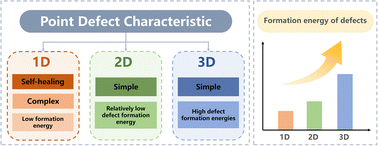Dimension-dependent intrinsic point defect characteristics of binary photovoltaic materials
Abstract
Point defects play a significant role in determining the crystallinity, optoelectronic properties, and carrier lifetime of photovoltaic materials. The open-circuit voltage (Voc) deficit associated with defects is one of the main factors limiting the power conversion efficiency (PCE) of solar cells. In particular, easily formed deep level defects within the bandgap act as electron–hole non-radiative recombination centers, resulting in Shockley–Read–Hall (SRH) recombination and leading to a large Voc loss. Generally, the formation of point defects in a semiconductor largely relies on its chemical structure. Compared with conventional 2D and 3D semiconductors, the complicated defects located in non-equivalent atomic sites with a low formation energy in asymmetric 1D structures give rise to a large Voc deficit, which is a great challenge towards further improving the solar cell efficiency. In this review, we introduce the dependence of defect properties on the dimensions among the binary compound semiconductors. Finally, effective strategies to improve the P-type conductivity of the material, as well as the mixing of 1D materials with other 2D or 3D materials to construct hybrid-dimensional semiconductor compounds, are proposed to enable defect control. From this, we provide guidance for breaking the bottlenecks of thin film solar cells.

- This article is part of the themed collection: 2023 Materials Chemistry Frontiers Review-type Articles


 Please wait while we load your content...
Please wait while we load your content...